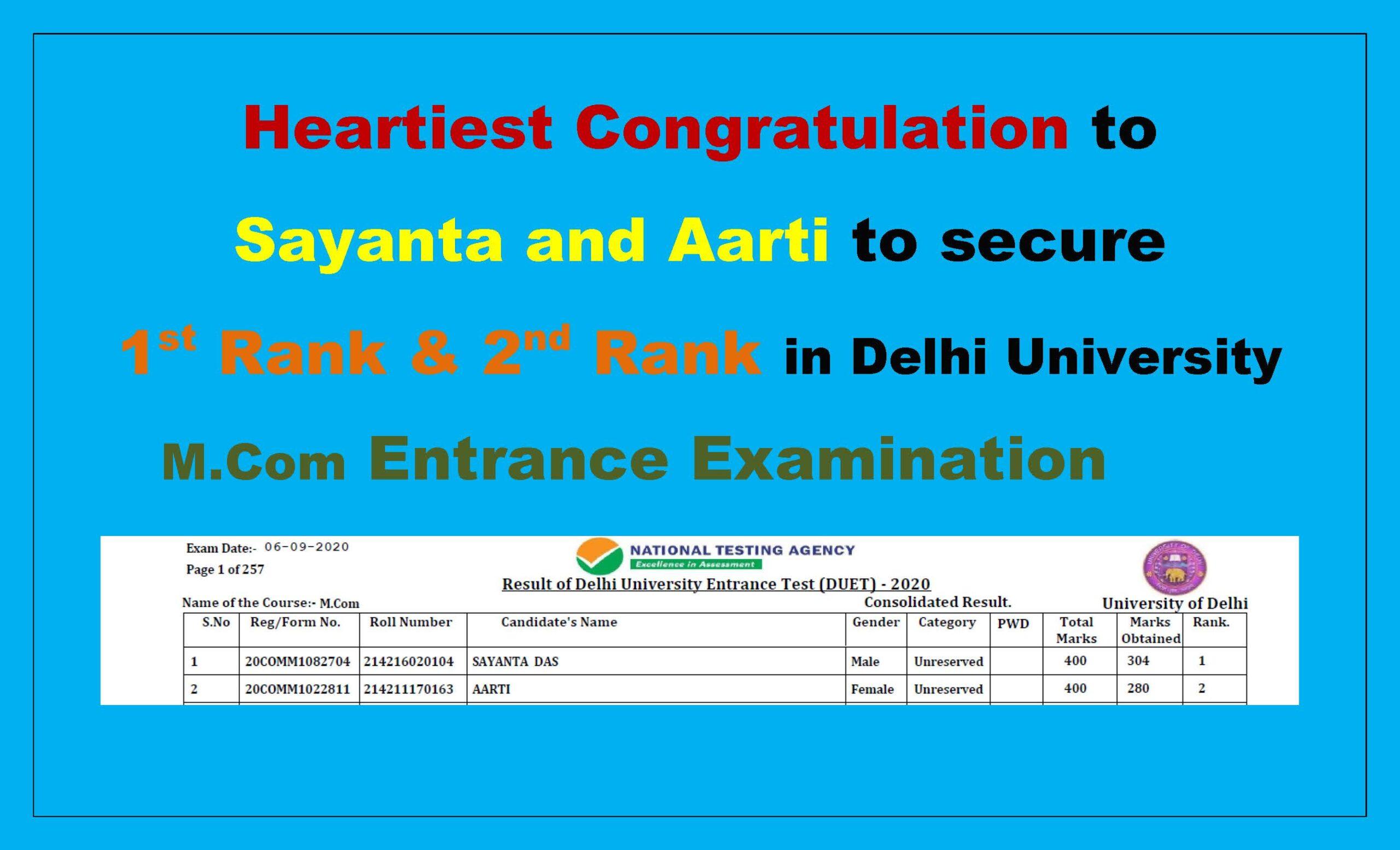Best M.Com Entrance Coaching in India | Delhi’s No. 1 Coaching Institute in M.Com Entrance Result
Admission is open for M.Com Entrance 2024 Examination. Join to get rank and admission in DSE- Delhi School of Economics & Regular college of Delhi University
M.Com Entrance (CUET) 2024 Batch :
M.Com Entrance Offline Batch – Class Schedule & Other Details
Target M.Com Entrance Examination 2024
Weekend Batch (9 AM- 4.30 PM)
| Days | 1st Period (9 AM to 11 AM) | 2nd Period (11 AM to 12.30 PM) | Lunch Break | 3rd Period (1PM to 3 PM) | 4th Period (3 PM to 4.30 PM) |
||||
|---|---|---|---|---|---|---|---|---|---|
| Saturday | Accounting Cost Accounting Contemporary Audit Income Tax Law and Accounts |
Dheeraj Sir | Law, Secretarial Practice & International Business | Dheeraj Sir | 12.30 PM – 1.00 PM | Micro Economics Macro- Economics Indian Economic Structure Public Finance |
Daniel Sir | Business Organization, Essential of Management, Office Management, Selling and Advertising, Marketing Practice and Finance |
Daniel Sir |
| Sunday | Accounting Cost Accounting Contemporary Audit Income Tax Law and Accounts |
Dheeraj Sir | Banking, Insurance & Finance | Dheeraj Sir | 12.30 PM – 1.00 PM | Business Mathematics Quantitative Economics Statistical Methods Applied & Business Statistics |
Daniel Sir | Business Organization, Essential of Management, Office Management, Selling and Advertising, Marketing Practice and Finance |
Daniel Sir |
| December | January | February | March | April | Total | |
| Saturday | 5 | 4 | 4 | 5 | 4 | 22 |
| Sunday | 5 | 4 | 4 | 5 | 4 | 22 |
| Total | 44 | |||||

Buy Link: Open
M.Com Entrance (CUET) Syllabus M.Com Entrance Question Paper CUET
M.Com Entrance (CUET) Resource CUET Official Website – Syllabus
CUET PG MCom Entrance E-Book : Link
1. PART-A will consist of 25 objective questions (MCQs) and will include English, General Awareness, Mathematical Aptitude and Analytical Skills.
2. PART-B will consist of 75 objective questions (MCQs) from the following Syllabus:
|
PART-A will consist of 25 objective questions (MCQs) Includes English, General Awareness, Mathematical Aptitude and Analytical Skills. |
||
| Section | Faculty | |
| Mathematical Aptitude and Analytical Skills |
Dharmendar Sir | |
| English and General Awareness |
Shivani Madam | |
| PART-B will consist of 75 objective questions (MCQs)
From the following Syllabus: |
||
| Section | Sub Section | Faculty |
| Economics | Micro Economics Macro- Economics Indian Economic Structure Public Finance |
Daniel Sir |
| Mathematics & Statistics | Business Mathematics Quantitative Economics Statistical Methods Applied & Business Statistics |
Daniel Sir |
| Accounting, Auditing & Taxation | Accounting Cost Accounting Contemporary Audit Income Tax Law and Accounts |
Dheeraj Sir |
| Banking, Insurance & Finance | Currency and Banking Law and Practice of Banking Development Banking Insurance Law and Accounts |
Dheeraj Sir |
| Business Organization & Management | Business Organization Essential of Management Office Management Selling and Advertising Marketing, Practice and Finance |
Santosh Sir |
| Law, Secretarial Practice & International Business | Business Law Company law and Secretarial Practice Trade of India |
Santosh Sir |
Economics Section
Micro Economics
1. Definition Nature and scope of economics, Marshall & Robins Views. Utility of Economics, Micro vs. Macromedia of Economics study, Economic Theory and Business Decisions.
2. Utility Analysis, Consumer Behaviour, Consumer’s equilibrium. Traditional approach and Indifference curve and Analysis: price income and substitution effects. Some application of indifference Curve Techniques, Elasticity of demand.
3. Production –Equal Product Curves, Scale of Production: Input-Output relationship, cost Curves; Variable cost conditions and law of variable proportions, Producers’ equilibrium. Product pricing –market format, perfect competition, Monopoly and imperfect completion.
4. Pricing of Factors of Production, Concept of Marginal Productivity, Theories of Rent,Wages, Theories of Interest and Profit.
Macro- Economics
1. Concept – Definition and scope of Macro-Economics, Statics and Dynamics, The Circular flow of Income. The Analysis and Measurement of Economic Activity – National Income Accounting – Concept and Definitions of National Income. Various component of National Income, Methods of Measurement of National Income and Welfare.
2. The consumption function – The Keynesion Comsumption Function, Relative Income Hypothesis, Permanent Income Hypothesis Multiplier and the Process of Income – Propagation. The investment function – Autonomous and Induced investment. Government and the Theory of Income Determination – Government Purchases and Income, Taxes and Equilibrium level of Income, Tax Multiplier Determination of the Equilibrium Level of Income – The Simple Keynesian Model.
3. Marginal Efficiency of Capital, Relation between MEC and MEI. The Derivation and Shift in IS and LM Curves, the Interaction between IS and LM Curves. The Acceleration Principle. Theories of Employment – Say’s Law of Market and Classical Theory of Employment, Saving Investment Analysis. An outline of Keynesian Theory of employment.
4. Theory of Inflation – Concepts of Inflation, Inflationary Gaps Demand Pull and Cost Push Inflation. The Philips Curve, Effects of Inflation, Anti-Inflation Policies – Mentary and Fiscal Policies. Fluctuation and Growth – Hawtrey, Hayek, Sehumpeter, Samuelson, Hicks. Theories of population – Malthusian Theory and Theory of Optimum Population.
Indian Economic Structure
1. Nature of Indian Economy, Features of a developing economy. Characteristics and problems of Indian Economy. Objectives of economics planning in India. India’s five year plans – Achievements and failures. Indian agriculture – Its features and problems. Agricultural development in planned era. Green revaluation, Agricultural marketing, Rural poverty and indebtedness. Rural industrialisation. Rural Development programmes. Cooperative movement.
2. Population growth and population explosion. Population policy and programmes. Problem of unemployment. Forms of unemployment. Employment programmes and poverty alleviation.
3.Large scale, small scale and cottage industries. Industrial development during five year plans. Public sectors and private sector. Industrial relations. Industrial policy. Industrial Sickness, Industrial finance. Money Market and Capital Market structure. Capital Formation, Indian Money Market and Fiscal policies, Deficit financing and its implications.
Public Finance
1. Public Finance – Definition and Scope; Public and Private finance.
2. Public revenue – Sources of Public revenue; Nature and Principles of taxation; classification of taxes; problems and principles of equity in taxation. Incidence of taxation; shifting of taxes. Effects of taxation. Requirements of a sound tax system. Canons of taxation.
3. Principle of maximum social advantage.
4. Public Expenditure – Classification, effects and canons of public expenditure, Public debt, External and internal debt. Methods of debt redemption. Capital levy, Deficit financing.
5. Indian Public Finance – Financial relations between the Central Government, State Government and local bodies, Finance commission, Financial Administration, Budget- Its preparation, legislation and execution.
6. Analysis of trends in Central Government’s Revenue, Expenditure and debt. Financing of five year plans, Deficit financing in India.
7. State and local finance, Heads of revenue and items of expenditure and related issues.
Mathematics & Statistics Section
Business Mathematics
1. Calculus : (Problems and theorems involving trigonometrically ratios are not to be done) Differentiation: Partial derivatives up to second order; Total differentials. Maxima and minima cases of one variable involving second or higher order; Cases of two variables involving not more than one constraint, Integration as anti-derivative process; Standard forms; Methods of regration –by substitution, by parts, and by use of partial functions; Definite regration; Finding areas in simple cases.
2. Matrices and Determinants: Definition of a matrix, Types of matrices; Algebra of matrices; Properties of determinants; Calculation of values of determinants upto Third order, Adjoint a matrix; elementary row or column operations; Finding inverse of a matrix through adjoint and elementary row and column operations; Solution of a system of linear equations having unique solution and involving not more than three variables.
3. Linear Programming – formulation of LPP: Graphical method of solution; Problems relating to two variables including the case of mixed constraints; Simplex Method – solution of problems upto three variables, Duality, Transportation Problem.
4. Compound interest and annuities certain, different types of interest rates; concept of present value and amount of a sum; equation of payments, types of annuities; present value and amount of an annuity, including the case of continuous compounding; analysis of annuity; valuation of simple loans and debentures; problems relating to sinking funds.
Quantitative Economics
1. Economics of a Fir – Applications of differential calculus, cost minimization, Profit Maximization, Price – Quantity Determination, Elementary Partial Differentiation and Economic application, Partial Elasticition, Elementary Integral calculus and Economics applications.
2. Linear programming – Meaning, Application, limitation Simple formulation, Graphic method, simplex method duality.
3. Games theory – Classifying pay off matrix, principle of dominance, Strategy – Pure Strategy and mixed strategies – 2x2mx2, 2xn games.
4. Decision Theory Decision making under risk, decision making under inconstanity- Maximum Criterion, Maximax Criterion, Hurvics, criterion savage criterion, laplace criterion Inventory Economics – Inventroy costs, various inventroy models – EOQ with uniform demand, production inventory model, Back-order inventory model Inventory model with quantity discount, price break approach, Re-order point safety stock and stock-outs, determining optimum safety stock levels, ABC analysis.
5. Input- Output Analysis – Meaning assumption viability of system, technological coefficient closed & open economy, determination of out-put labour requirement price equibrium and value added.
6. Query Problems – Query discipline formulae for solving single-channel quering problems.
Statistical Methods
1. General – The Nature and scope of statistics: Definition of statistics. Law of statistical Regularity: Law of Inertia of Large Numbers. Probability and sampling. limitations of statistics.
2. Methods of statistical Enquiry – Types and characteristics of Units. Methods of collection of data; Questionnaire and schedule; pproximations and accuracy, errors and their effects.
3. Classification and Tabulation – Objects, generalrules for the construction of tables; statistical series.
4. Measure of Central Tendency – Mean Mode, Median, quartile Harmonic and geometric mean.
5. Measurement of Disperson and skewness – Range, quartile deviation, mean deviation, standard deviation and their coefficients; Measures of skewness.
6. Correlation Analysis – Graphic method, scatter diagram, Karl Pearson’s coefficient of correlation, Spearman’s ranking method, Lag and Lead, probable and standard error.
7. Regression Analysis – Linear regression, regression lines, regression equations.
8. Interpolation – Assumptions, Newtons’ advancing differences, larganges’ formula; parabolic curve method; binominal expansion method.
Applied & Business Statistics
1. Statistical System in India- Indian Statistical Machinery – Organisation at Central State level, National Sample Survey – Design and Technique. Agricultural Statistics in India – Nature of Crop estimates, estimation of Area and yield, Industrial Statistics, Annual Survey of Industries. Statistics of Prices, Wage, Trade and Transport.
2. Population statistics – Vital statistics, Computation of birth, death and survival rates. Methods of population projection. Population census in India.
3. Analysis of Time series – Trend Measurement Different Method of Computing Seasonal Indices. Cyclical and Irregular-Fluctuations.
4. National Income Statistics: Methods of Measuring National Income and Related Aggregates. Statistical Quality Control Construction and uses of control charts.
Accounting, Auditing & Taxation Section
Accounting
1. Accounting an introduction : Accounting Standard – national and international, Partnership Accounts – Admission, retirement & death, Dissolution of partnership firm.
2. Absorption, Amalgamation and reconstruction of companies, Liquidation of companies and preparation of a Liquidator’s Final Statement of Account.
3. Hire purchase and instalment accounts, Royalties accounts, insolvency accounts.
4. Branch account: Voyage accounts, Accounts of empties and packages; Insurance Claim for loss of Stock and loss of profit.
Cost Accounting
1. Definition, Nature, Scope and Significance, Cost Unit, Cost Centre, Elements of Costs, System of ascertainment of cost, Control and ascertainment of Materials, Labour and Overhead Costs, Allocation, Apportionment and Absorption of Overheads.
2. Single Output or Unit Costing, Contract and Job Costing, Calculation of Tender, Quotation, Estimated Price, Process and Operating Costing
3. Marginal Costing – its use in Management Standard Costing, Variance Analysis.
4. Integrated Accounts, Reconciliation of Cost and Financial Accounts, Cost Accounting/Cost Control Accounts, Interfirm Comparison.
Contemporary Audit
1. Introduction: Meaning and objectives of auditing : Types of audit; Internal audit. Audit Process: Audit programme; Audit and books; Working papers and evidences; Consideration for commencing an audit; Routine checking and test checking. Internal Check System: Internal Control.
2. Audit Procedure: Vouching; Verification of assets and liabilities. Audit of Limited Companies: Company auditor- Appointment, powers, duties, and liabilities.
3. Auditing Standards – Appointment, power, duties and liability of Auditor. Broad Outlines of Company audit and auditor’s report. Special audit – Banking companies, Educational Institutions, Insurance companies. Investigation, Audit of non profit organisation, Divisible Profit & Dividend.
4. Recent Trends in Auditing – Nature and significance of cost audit; Tax audit, Management audit, Computerised Audit.
Income Tax Law and Accounts
1. Basic Concepts : Income, agricultural income, casual income, assessment year previous year, gross total income, total income person. Tax evasion, avoidance and tax planning. Basic of Charge; Scope of total income, residence and tax liability, income which does not form part of total income. Deduction from Gross total income.
2. Head of the Income: Salaries; Income from house property; Profit and gains to business or profession. Capital gains; Income from other sources.
3. Computations of total income of an individual, HUF and firm.
4. Deemed income: Aggregation of Income, Set-off and carry forward of losses; Tax Authorities; Assessment procedures.
Banking & Insurance Section
Currency and Banking
1. Functions significance of money, various forms of money, Causes, remedies and effects of Inflation, Deflation and Reflation Indian Money Market, Principles Methods of Note issues, Monetary Standard – Gold Standard, Bi-metallise and Managed Currency Standard.
2. Meaning and significance of credit. Factors influencing the Volume of credit in Country, Credit Creations of Bank, Credit Control by RBI.
3. Functions of Commercial Bank, Types of Banks, Unit and Branch Banking System, concept of Mix Banking, Central Bank and its functions, Reserve Bank of India, State Bank of India, Regional Rural Banks, Progress of Nationalized Banks in India.
4. Concept of Foreign Exchange and Exchange Rate, Factors causing fluctuation in Exchange Control Meaning, Objective and Methods.
Law and Practice of Banking
1. The Ordinary, practice of bankers with regard to the opening and conduct of banking accounts, closing of accounts. Banker and customer – General and special relations.
2. Law relating to cheques, bill of exchange and other negotiable instruments. Discounting of Bill of Exchange, the practice relating to cheques bills of exchange and other negotiable instruments.
3. Banker’s credit, advance and overdrafts Traveller cheque, letter of credit, confirmed bankers credit, unconfirmed bankers credit, acceptance credits and documentary credit.
4. Revolving credit, banker’s advance against marketable securities, goods & produce, debentures and life insurance policies. Unsecured advances – guarantees, precautions/ duties of Banker.
Development Banking
1. Meaning, determinant and obstacles of economic development, sources and problems of Rural and Industrial Finance.
2. Meaning objective, characteristics and functioning of Development Banks, Difference between Commercial and Development Banks
3. Role of Commercial Banks in Agricultural and Industrial Finance. Terms lending operations of Land Development Banks.
4. National Bank for Agricultural and Rural Development (NABARD) – Objectives organisation and functions.
5. Structure of Development Banks in India, progress of these banks (terms lending institutions) and deficiencies in their working.
6. National Level Financial Corporation – IFCI, IDBI, ICICI & IRBI – their objectives functions and evaluations of performance.
7. State level Financial Corporation – SFCs and SIDCs – their objectives organizations,functions and evaluations of performance.
8. Capital Market in India & Industrial Growth – Structure, present position, problems and steps taken by the government to active and Capital market.
Insurance Law and Accounts
1. Introduction to Insurance: Purpose and need of insurance, Insurance as a social security tool; Insurance and economic development, Fundamentals/ Principles of Insurance. Contract of Insurance.
2. Life Insurance – Principles and practice of life assurance. Life assurance contract, their nature and characteristics, Parties to the contract and their rights and duties. Conditions and terms of policy. Nominations and Assignment Practice in connection with collection of premium, revivals, loans, surrenders, claims, bonuses and annuity payments, Mortality Table.
3. Fire Insurance – The basic principles of Fire Insurance contracts. Fire Policy, conditions, Assignment of Policy, Claims. Marine Insurance – General Principles – Insurable interest and value disclosure Marine Policy and their conditions, Premium double insurance: assignment of policy warranties the voyage, Loss and abandonment: partial losses and particular charges; salvage; total losses and measures of indemnity, Subrogation.
4. Insurance Intermediaries – Agents and Procedure for Becoming and Agent: Pre requisite for obtaining a license: Duration of license; Cancellation of license, Revocation of suspension/ termination of agent appointment; Code of conduct; Unfair practices, Insurance Accounts – Life Insurance and General Insurance Company.
Business Organisation & Management Section
Business Organisation
1. Definition, Nature and scope of business, Business and society, Social Responsibility of Business, Factors Determining the size of business unit. Forms of business organization – A Comparative study.
2. Monopolistic combination, Production management, Rationalization & methods of remunerating labour.
3. Organization process – Importance, principles, Various aspects of organization, organization structure, Departmentation, Line and Staff Relationships, Span of control, Delegation of authority, Decentralization.
4. Produce and stock Exchange : its organization and economic functions.
Essential of Management
1. Nature, scope and functions of Management, Evolution of Management thought, various approaches to management, Functions of a manager, Introduction to Corporate Social Responsibility.
2. Planning: Objective, Nature and process of planning, SWOT Analysis, formulation of plans, Decision making process. Organising: Objectives, nature and process of organizing formal and informal organization, authority and responsibility, delegation and empowerment, centralisation and decentralisation, concept of departmentation,Organisation Chart, Line, Staff and functional relationships.
3. Staffing: Concept, Manpower Planning, recruitment, selection, training and development, performance appraisal. Directing: Concept and techniques of Motivation and Leadership. Process and barriers to communication.
4. Controlling: Concept, Need and Techniques. Controlling: concept, process and techniques and control, Management by Objectives (MBO) Management by Exception (MBE), Essentials of effective control, Managerial effectiveness.
Office Management
1. Office: Meaning, importance, activities, emerging trends, concept of paperless office. Office management: Meaning, functions. Office organization: Definition, characteristics, types of organisation, office systems and procedures, charts and manuals. Office location, layout and environment, flow of work.
2. Computer fundamentals: Concept, Components and types of computers. Operating system: Concept, functions, types. Managing files and folders. Internet: Basics, features, methods of access. Applications and benefits of Computerisation and Internet in office. Introduction to word processing and spreadsheets: Templates and creation of documents, editing and formatting, creating tables, basic applications.
3. Office record management: Importance, filing essentials, modern methods of filing, modern filing devices, indexing system. Office Forms: Meaning, principles, design and control of office forms. Office Supplies: Management and control of office supplies. Office Correspondence: Types, centralized and decentralized correspondence, procedure of handling inward and outward correspondence, electronic communication.
4. Office Information System: Concept, basic types and business applications. Planning and designing of Information System: System Development Life Cycle, Flow Charts. Office reports: Types of reports, report writing and precis writing. E-Commerce: Concepts, types, business models, e-payment systems.
Selling and Advertising
1. Selling : Concept, Nature and Role in Marketing. Personal Selling: Evolving face of Personal Selling, Nature and importance of Personal Selling, Characteristics of a successful salesperson, Sales as a career option, Sales training, Consumer psychology and buying motives, Selling of consumer and Industrial Products (goods and services)
2. Selling process: Prospecting, Pre-approach, Approach, Sales presentation and demonstration, Handling objections, Closing the sale, After sale service. Effective selling techniques, role of relationship marketing in personal selling, tools of selling, Motivating and Remunerating Salespersons.
3. Advertising: Concept, role, functions, scope and types, Economic, Social, Legal and Ethical aspects of Advertising. Advertising Appeals: Meaning, types and methods, Advertising as a persuasive communication process. Advertising Design: Characteristics and basic elements of Advertising copy. Creation, Production and Planning of Advertisements. Advertising Budget: Types, components and process of preparing. Advertising Agency: Functions and selection of agency.
4. Advertising as a component of Integrated Marketing Communication, AIDA and DAGMAR model. Advertising Media: Types (Print, Outdoor, Electronic and other), Characteristics, merits and limitations of each media type. Media planning: Selection of media category; their reach, frequency, impact, cost and other factors influencing media choice. Problems in reaching rural and remote audience. Evaluation of Advertising effectiveness: Importance, difficulties and methods of measuring advertising effectiveness.
Marketing, Practice and Finance
1. Introduction: Nature and scope of marketing: Importance of marketing as a business function and in the economy; Marketing concepts- traditional and modern; Selling Vs. Marketing; Marketing mix; Marketing environment.
2. Consumer Behaviour and Market segmentation; Nature, scope and significance of consumer behaviour; Market segmentation Concept and importance; basis for market segmentation Promotion; Methods of promotion; Optimum promotion mix; Advertising media – their relative merits and limitations; characteristics of an effective advertisement; Personal selling; Selling as a career; Classification of a successful sales person; Functions of salesman.
3. Product: Concept of product, consumer and industrial goods; Product planning and development; Packaging – role and functions; Brand name and trade mark; After sales service; Product life cycle concept. Price: Importance of price in the marketing mix; Factors affecting price of a product / service; Discounts and rebates.
4. Distribution Channels – concept and role; Types of distribution channels; factors affecting choice of a distribution channel; Retailer and wholesale; physical distribution of goods; Transportation; warehousing; inventory control; order processing.
Law, Secretarial Practice & International Business Section
Business Law
Main Principles of Indian law relating to:
1. Contract
2. Agency, Sale of Goods
3. Partnership, Negotiable Instruments and Hundies and Consumer Protection Act 1986
4. Common Carriers and Carriage of Goods of Land and Air. Foreign Exchange Management Act. 2000 : Definitions & Main provisions.
Company law and Secretarial Practice
1. Company: Definition, Classification, Incorporation, Memorandum of association, Articles of Association. Doctrine of constructive notice, Doctrine of Indoor management, Commencement of Business. Company Management: Appointment, Rights and obligations of Directors, Managers and secretary.
2. Steps before issue of prospects, Definition and contents of prospectus, Liability for untrue statements. Shares: Definition, share Vs stock, classes of shares, voting rights, issue of shares at per, premium and discount, ESOP, Bonus, Rights, Buyback, Public shares at par, premium and discount, ESOP, Bonus, Rights, Buyback, Public issue, Calls, Forfeiture, Lean and Surrender, Transfer and transmission, statutory restriction on transfer, Borrowing power, mortgages and changes, Debentures.
3. Secretarial Practice: Duties and responsibilities of Company Secretary, secretarial duties relating to issue and allotment of shares, Calls, forfeiture Lien and transfer of shares. Majority powers and minority rights, revelation of oppression and management. Specimen of certificate of incorporation. Certificate of commencement of Business, Share certificates and share warrants, Dematerialization of shares.
4. Meeting and proceedings: Provisions relating to the company and Board meetings, Secretarial duties relating to meetings, Notice, Agenda, Proxy, Motion, Resolution, Minutes and Reports.
Trade of India
1. Introduction – Trade its meaning and types. Difference between internal and international trade. Theories of International Trade with particular reference to the theory of comparative cost. Trade : Terminology and abbreviations. India’s Internal Trade- Characteristics and Problems. Coastal trade and trade of Uttar Pradesh.
2. Foreign Trade of India – Brief history before independence Recent trends in India’s Foreign Trade. Composition of Imports and Exports – Changes during planning period. Important items of imports and exports.
3. Direction of India’s Foreign Trade – Changes in Directional pattern during planning period. India’s Major trading partners. State trading Organisations, Financing of India’s foreign trade role of EXIM, Bank ECGC and other institutions in financing of foreign trade, STC MMTC.
4. Trade Policy in India – General Developments during planning period. Import substitution and Export promotion. Recent changes in trade policy, Trade agreements – Bilateral and Multilateral Trade Agreements. GATT & UNCTAD. India’s Balance of Trade and Balance of Payments – Trends during planning period. Problems of Bot, BOP and corrective measures.
What we provide :
- Subject Wise Study Materials +
- Unit-wise Practice Set +
- Subject wise Test Paper +
- Subject wise Scanner
Subject wise Study Materials Unit Wise Practice Set Subject Wise Test Paper Subject Wise Scanner
M.Com Entrance Online Batch – Our Results
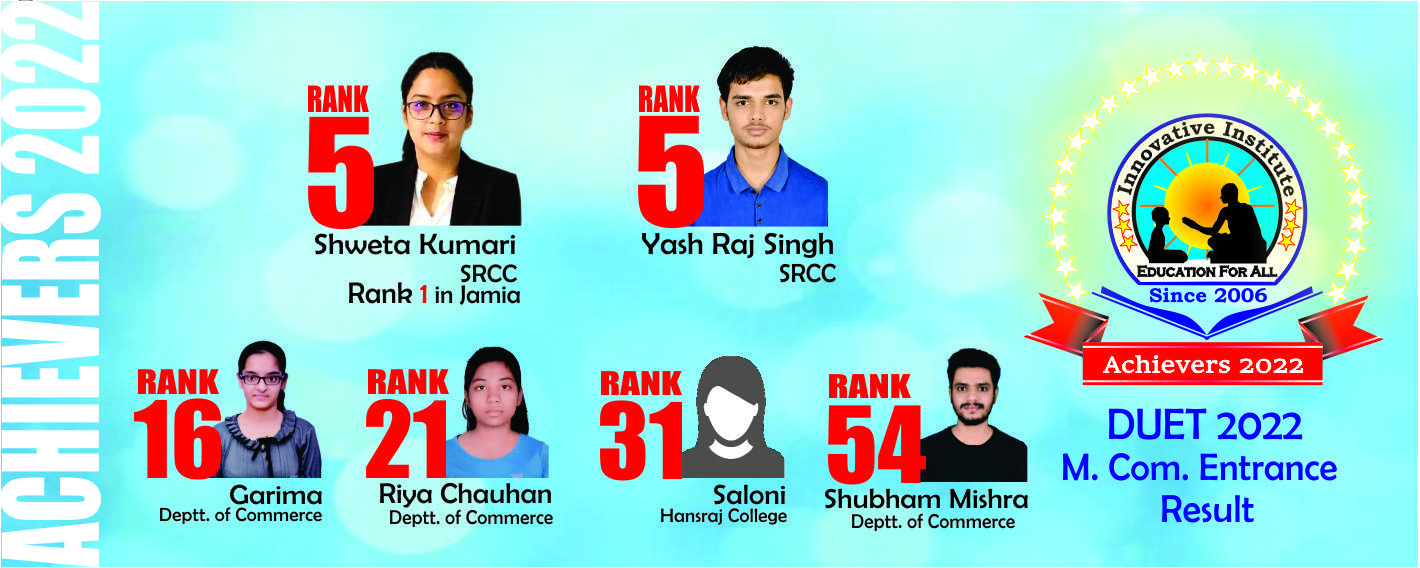
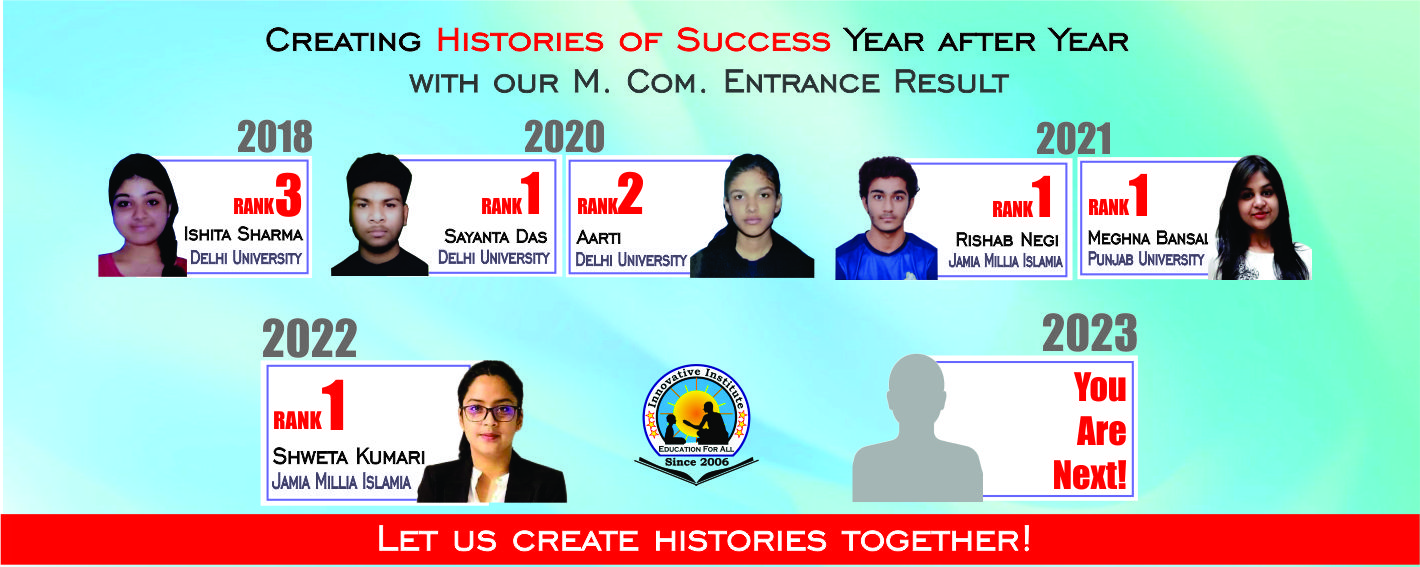
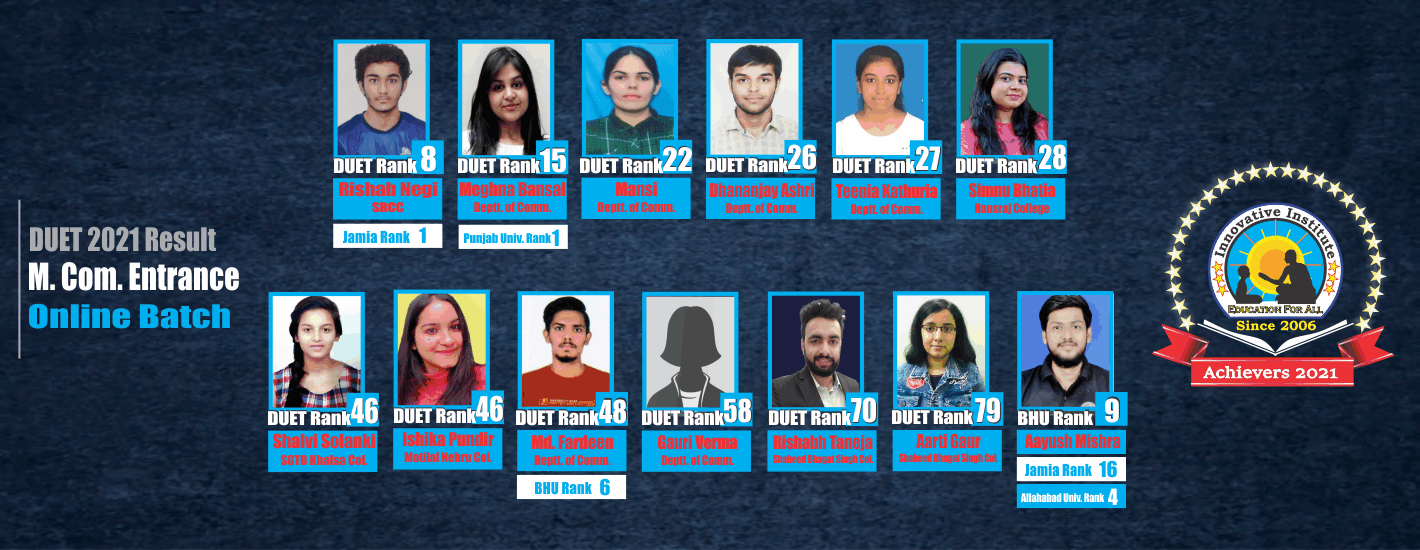
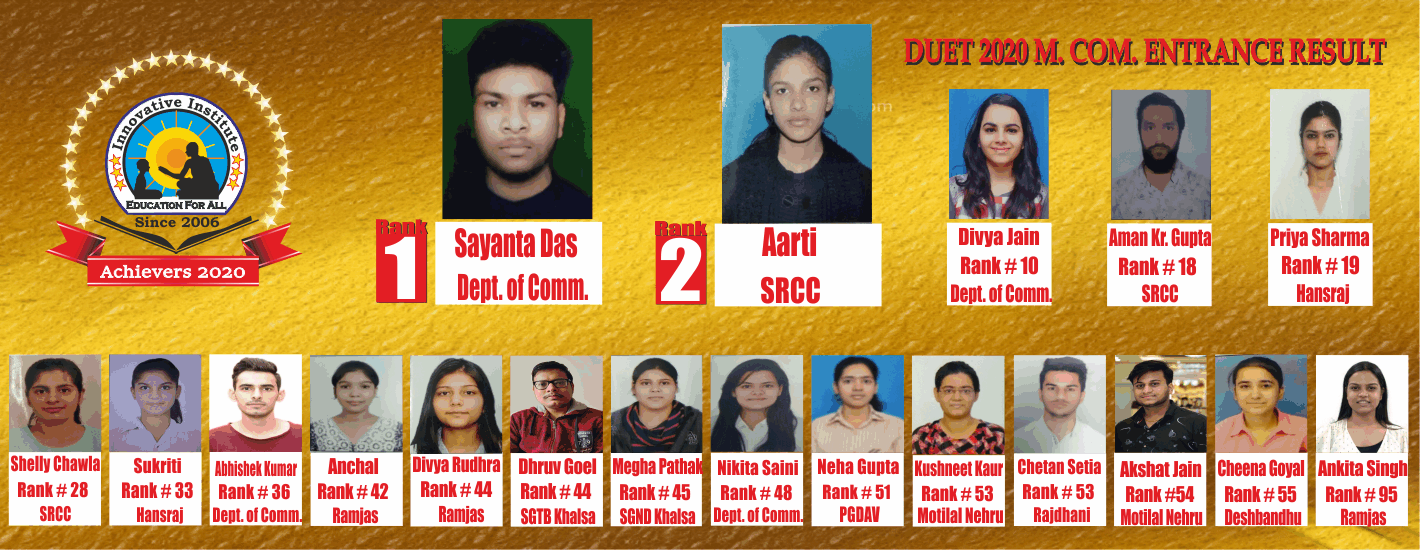
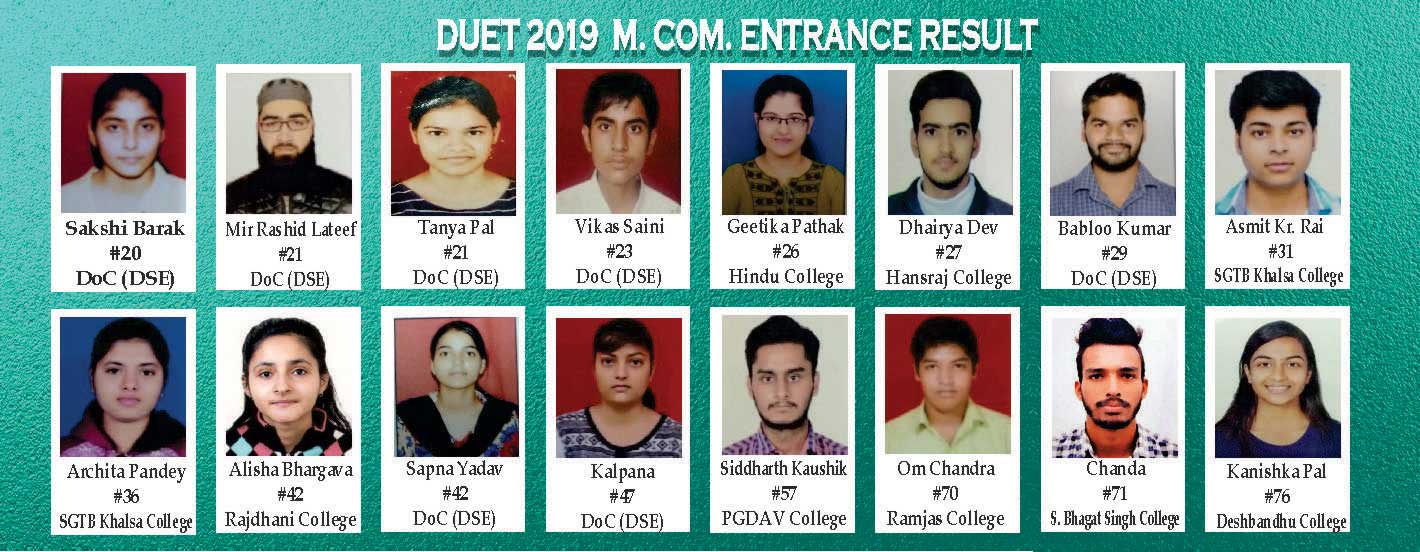
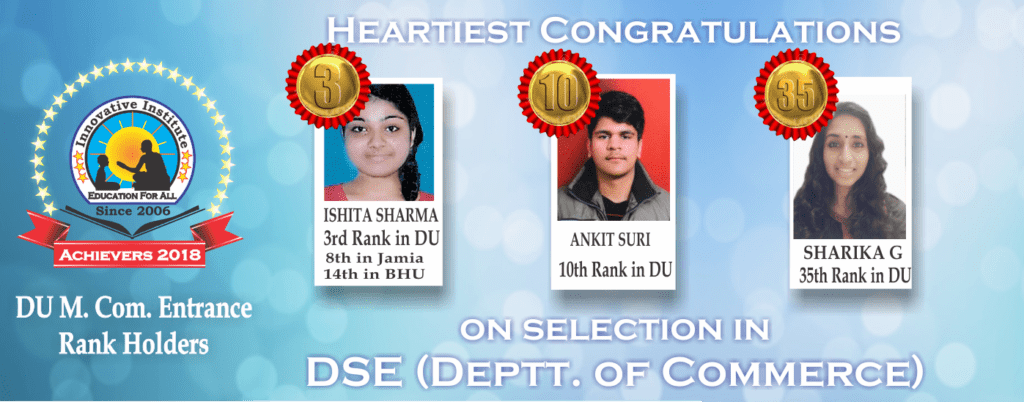
Achiever 2020: Delhi University – M. Com Entrance Examination
1. All over India 1st Rank : SAYANTA DAS ; Got 304 Marks out of 400 Marks: From St. Anthony’s College Shillong, Meghalaya and got admission to DSE – Department of Commerce
2. All over India 2nd Rank : AARTI ; Got 280 Marks out of 400 Marks : From SPM College and got admission to SRCC
3. All over India 10th Rank : Divya Jain ; Got 246 Marks out of 400 Marks : From Shaheed Bhagat Singh College and got admission to DSE – Department of Commerce
4. All over India 18th Rank : Aman Kumar Gupta ; Got 233 Marks out of 400 Marks : From Sri Aurobindo College(EVE) and got admission to SRCC
5. All over India 19th Rank : Priya Sharma ; Got 232 Marks out of 400 Marks : From Zakir Hussain College and got admission to Hans Raj College
6. All over India 28th Rank : Shelly Chawla ; Got 221 Marks out of 400 Marks : From Laxmi Bai College and got admission to SRCC
7. All over India 33th Rank : Sukriti ; Got 215 Marks out of 400 Marks : From Jesus & Marry College and got admission to Hans Raj College
8. All over India 36th Rank : Abhishek Kumar (OBCNC); Got 212 Marks out of 400 Marks : : From Shaheed Bhagat Singh College and got admission to DSE – Department of Commerce
9. All over India 42th Rank : Anchal ; Got 205 Marks out of 400 Marks : From PGDAV College and got admission to Ramjas College
10. All over India 44th Rank : Divya Rudra ; Got 202 Marks out of 400 Marks : From Kamla Nehru College and got admission to Ramjas College
11. All over India 44th Rank : Dhruv Goel ; Got 202 Marks out of 400 Marks : From Shyam Lal College and got admission to Sri Guru Teg Bahadur Khalasa College
12. All over India 45th Rank : Megha Patak ; Got 202 Marks out of 400 Marks : From Kamla Nehru College and got admission to Sri Guru Teg Bahadur Khalasa College
13. All over India 48th Rank : Nikita Saini (OBCNC) ; Got 197 Marks out of 400 Marks : From Hindu College and got admission to DSE – Department of Commerce
14. All over India 51th Rank : Neha Gupta ; Got 194 Marks out of 400 Marks : From PGDAV College and got admission to PGDAV college
15. All over India 53rd Rank : Chetan Setia ; Got 193 Marks out of 400 Marks : From Zakir Hussain College and got admission to Rajdhani College
16. All over India 53rd Rank : Kushneet Kaur ; Got 193 Marks out of 400 Marks : From Mata Sundari College and got admission to Motilal Nehru College
17. All over India 54th Rank : Akshat Jain ; Got 191 Marks out of 400 Marks : From Zakir Hussain College and got admission to Motilal Nehru College
18. All over India 55th Rank : Cheena Goyal ; Got 190 Marks out of 400 Marks : From PGDAV College and got admission to Deshbandhu college
19. All over India 95th Rank : Ankita Singh (EWS category) ; Got 150 Marks out of 400 Marks : From Ramjas College and got admission to Moti Lal Nehru College
Under Expert Guidance of
Dheeraj Sir
Daniel Sir
Innovative provides expert coaching for M.Com Entrance. Innovative Institute among the best institutes in Delhi that provide coaching for M.Com Entrance Weekend Batch (Saturday & Sunday) throughout the year. We start our batches from 1st week of July and time to time we start fresh batches where even the students in older batches who want to reinforce some topics can attend them as per their requirement and suitability. These batches are designed for college going students. We conduct doubt cession and Test Series after completion of the syllabus. In order to reduce the burden of students, we have compiled and framed our study material from best possible resources
M.Com Entrance exam for the student to be eligible for M.Com Delhi University exam, you must have done your graduation and clear the entrance exam with merit. If you wish to get a seat in the best college (if in Delhi School of Economics DSE) in D.U., then you must crack the entrance exam with a good score.
Our M.com Entrance Result – 2019 Delhi University :-
1. 20th Rank : Sakshi Barak (Got 210 out of 380) : From Jesus & Mary College and got admission to DSE – Department of Commerce
2. 21th Rank : Tanya – 1st Rank in OBC Category (Got 209 out of 380) : From IP College and got admission to DSE – Department of Commerce
3. 21th Rank : Mir Rashid Lateef (Got 209 out of 380) : From Kashmir University and got admission to DSE – Department of Commerce
4. 23rd Rank : Vikas Saini – 2nd Rank in OBC Category (Got 207 out of 380) : From Ramjas College and got admission to DSE – Department of Commerce
5. 26th Rank : Geetika Pathak (Got 204 out of 380) : From Acharya Narendra Dev College and got admission to Hindu College
6. 27th Rank : Dhairya Dev (Got 203 out of 380) : From Sri Aurobindo College and got admission to Hans Raj College
7. 29th Rank : Babloo Kumar – 4th Rank in OBC Category (Got 201 out of 380) : From DU SOL and got admission to DSE – Department of Commerce
8. 31st Rank : Asmit Kumar Rai (Got 199 out of 380) : From Sri Aurobindo College and got admission to Hans Raj College
9. 31st Rank : Ankit Kaushik (Got 199 out of 380) – Our Postal Coaching Student : From Zakir Hussain College and got admission to Hans Raj College
10. 36th Rank : Archita Pandey (Got 194 out of 380) : From Shyam Lal College and got admission to Sri Guru Tegh Bahadur Khalsa College
11. 42nd Rank : Alisha Bhargava (Got 188 out of 380) : From Sri Guru Gobind Singh College of Commerce and got admission to Rajdhani College
12. 42nd Rank : Sapna Yadav – 16th Rank in OBC Category (Got 188 out of 380) : From Hans Raj College and got admission to DSE – Department of Commerce
13. 45th Rank : Ashita Adhikari (Got 185 out of 380) : From Kirori Mal College and got admission to ARSD College
14. 47th Rank : Kalpana – 7th Rank in SC Category (Got 183 out of 380) : From Keshav Mahavidalya and got admission to DSE – Department of Commerce
15. 57th Rank : Siddharth Kaushik – 8th Rank in EWS Category (Got 173 out of 380) : From Sri Aurobindo College and got admission to PGDAV College
16. 70th Rank : Om Chandra – 23th Rank in SC Category (Got 160 out of 380) : From Shyam Lal College and got admission to Ramjas College
17. 71st Rank : Chanda – 24th Rank in SC Category (Got 159 out of 380) : From Shivaji College and got admission to Shaheed Bhagat Singh College
18. 76th Rank : Kanishka Pal – OBCNC Category (Got 154 out of 380) : From Kirori Mal College and got admission to Deshbandhu College
Our M.com Entrance Result – 2019 Jamia Millia Islamia University :-
1. 5th Rank : Geetika Pathak
2. 13th Rank : Mir Rashid Lateef
3. 25th Rank : Vaishali Thakur : From Mata Sundari College and got admission to Jamia Millia Islamia University
4. Nidhi Bhat : From ARSD College and got admission to Jamia Millia Islamia University ( MA – Human Resource Management)
Our M.com Entrance Result – 2019 B.H.U :-
1. 14th Rank : Archita Pandey
2. 147th Rank : Aman Kumar Singh – Our Postal Coaching Student : From Purnia College Purnia (Bihar) and got admission to Main Campus BHU
PM3. 172th Rank : Anushka Tyagi
Our M.com Entrance Result – 2019 CU CET :-
17th Rank : Om Chandra – 3rd Rank in SC Category
47th Rank : Chanda – 7th Rank in SC Category
51st Rank : Vikas – Got admission in Rajasthan Central University
79th Rank : Pooja Yadav -24th Rank in OBC Category – Got admission in Rajasthan Central University
172th Rank : Kirti Motwani – Got admission in Rajasthan Central University
290th Rank : Md. Zishan -113th Rank in OBC Category – Got admission in Rajasthan Central University
Md. Haroon – From ICSC Srinagar – Got admission in Kashmir Central University
Other Students : Delhi University SOL and other Universities
Achiever 2018 :
Our M.com Entrance Result – 2018 Delhi University :-
3rd Rank : Ishita Sharma (Got 285 out of 396)
10th Rank : Ankit Suri – 1st Rank in OBC Category (Got 262 out of 396
35th Rank : Sharika G – 4th Rank in SC Category (Got 234 out of 396)
81st Rank : Ritika Tandon – General Category (Got 186 out of 396)
84th Rank : Salman Khan – 30th Rank in OBC Category (Got 183 out of 396)
Other Students : Delhi University Regular course, SOL and other Universities
Our M.com Entrance Result – 2018 Jamia Millia Islamia University :-
8th Rank : Ishita Sharma
34th Rank : Salman Khan- 9th Rank in Muslim Category- 4th Rank Muslim OBC Category
Our M.com Entrance Result – 2018 B.H.U :-
14th Rank : Ishita Sharma

